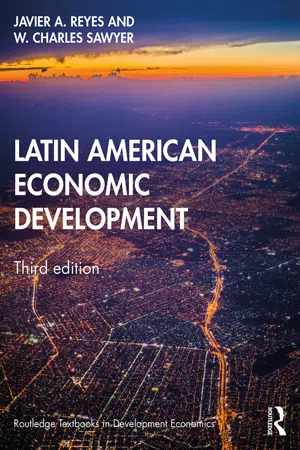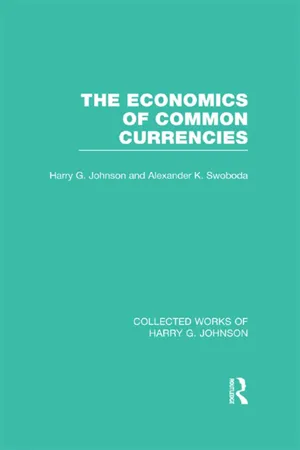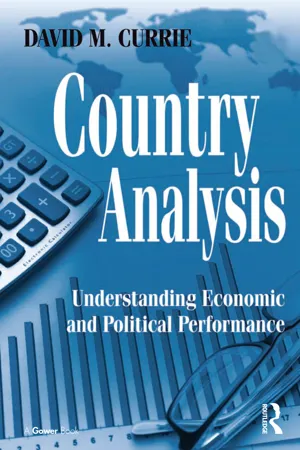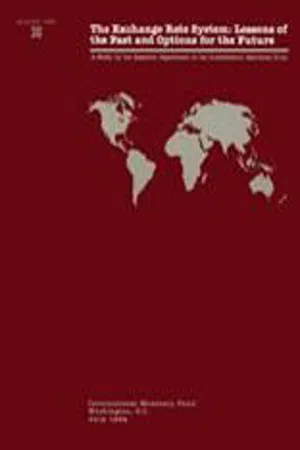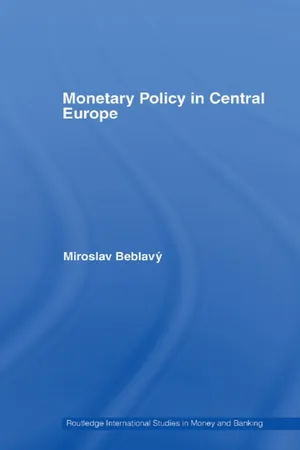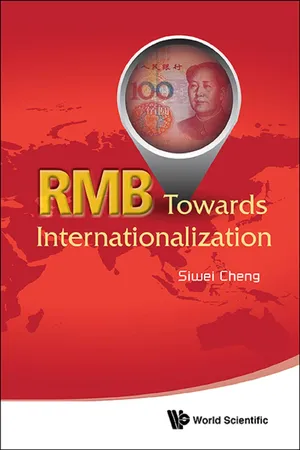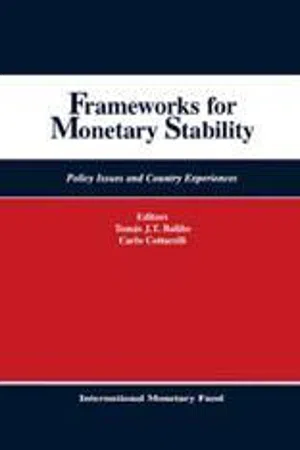Economics
Nominal Exchange Rate
The nominal exchange rate refers to the price of one country's currency in terms of another country's currency. It is the rate at which two currencies can be exchanged. This rate is often quoted in the foreign exchange market and is used for international trade and investment.
Written by Perlego with AI-assistance
Related key terms
9 Key excerpts on "Nominal Exchange Rate"
- eBook - ePub
- (Author)
- 2023(Publication Date)
- Wiley(Publisher)
depreciating against the US dollar.These exchange rates are referred to as nominal exchange rates. In contrast, real exchange rates are indexes that often are constructed by economists and other market analysts to assess changes in the relative purchasing power of one currency compared with another. Creating these indexes requires adjusting the Nominal Exchange Rate by using the price levels in each country of the currency pair (hence the name “real exchange rates”) to compare the relative purchasing power between countries.In a world of homogenous goods and services, and with no market frictions or trade barriers, the relative purchasing power across countries would tend to equalize: Why would you pay more, in real terms, domestically for a “widget” if you could import an identical “widget” from overseas at a cheaper price? This basic concept is the intuition behind a theory known as purchasing power parity (PPP), which describes the long-term equilibrium of Nominal Exchange Rates. PPP asserts that nominal exchange rates adjust so that identical goods (or baskets of goods) will have the same price in different markets. Or, put differently, the purchasing power of different currencies is equalized for a standardized basket of goods. - eBook - ePub
- Anthony J. Makin(Author)
- 2016(Publication Date)
- Routledge(Publisher)
e↑). This suggests that the Nominal Exchange Rate is currently too strong and is therefore overvalued. On the contrary, ifthe Nominal Exchange Rate needs to appreciate to restore the PPP equilibrium. Hence, it is presently too weak relative to its long-run equilibrium value. So it is undervalued.The notions of undervaluation and overvaluation of the Nominal Exchange Rate relative to implied equilibrium exchange rate values are illustrated in Figure 3.4 . Note that when the local currency is undervalued, competitiveness temporarily improves, whereas competitiveness worsens when the local currency is overvalued.To recap, exchange rate changes alter the prices of domestically produced goods and services relative to goods and services produced in foreign economies. Hence, they affect the profitability of exporting and the cost of importing from abroad. Competitiveness either improves or worsens over the short term because of Nominal Exchange Rate movements or because domestic prices or costs change relative to prevailing prices or costs in major trading partners.FIGURE 3.4 Currency undervaluation and overvaluationSince Nominal Exchange Rates are far more variable than relative national price levels or relative labour costs, which influence price levels, sharp Nominal Exchange Rate swings account for most of the real exchange rate movements that occur over the short to medium term.KEY POINTS1. The exchange rate affects the prices at which a country trades with the rest of the world and is central to international monetary economics.2. - eBook - ePub
- Javier A. Reyes, W. Charles Sawyer(Authors)
- 2019(Publication Date)
- Routledge(Publisher)
In this section, we explain the concept of the real exchange rate. The real exchange rate is the Nominal Exchange Rate adjusted for changes in both domestic and foreign prices. As we will see, the real exchange rate is important in the context of Latin America. At times in the region, the Nominal Exchange Rate can be quite deceptive. An understanding of the real exchange rate is crucial in understanding the economic changes that have occurred in the region over the past several decades. To borrow a thought from Paul Samuelson, the real exchange rate is an important concept, but it is not obvious. To illustrate this, let’s consider a normal economic transaction. Suppose that last year you exchanged a dollar for 1,000 pesos and crossed the border and purchased a bottle of soda. Now, assume that prices in the US are constant and that the rate of inflation in RCILA is 100 percent. A year later, the same transaction might look something like this. You now exchange a dollar for the 2,000 pesos and cross the border and buy a bottle of soda. Notice what has occurred. The Nominal Exchange Rate has changed dramatically. However, a dollar still bought you a bottle of soda. Adjusted for inflation, the real exchange rate has not changed. Just a bit of consideration of this example illustrates how deceptive the Nominal Exchange Rate can be. The example may seem extreme, but, as we will see in Chapter 11, situations such as this were all too real in Latin America in the late twentieth century. To understand the real exchange rate requires some logic and arithmetic. The starting point is the law of one price. The law of one price is the simple statement that identical goods sold in competitive markets should cost the same everywhere when prices are expressed in terms of the same currency. The example above was an illustration. If a bottle of soda cost a dollar in the US, then it should also cost a dollar across the border. One’s first reaction may be that this is ridiculous - eBook - ePub
The Economics of Common Currencies
Proceedings of the Madrid Conference on Optimum Currency Areas
- Harry Johnson, Alexander Swoboda(Authors)
- 2013(Publication Date)
- Routledge(Publisher)
ceteris paribus will hold smaller real balances of money. This is tantamount to saying that the money prices of goods other than bonds are also higher in the inflating country than in the other. Under fixed exchange rates, nominal as well as real rates of interest are equalized.Qualitatively the effects of the prohibition of trade in money are the same as the effects of the prohibition of trade in any commodity. Quantitatively, however, the effects probably are greater than with most other commodities. First, money is fungible and most nearly costless to arbitrage in time and space. Flexible exchange rates impose a severe cost on the arbitrage of money across national boundaries. The second reason focuses on the unique role of money in controlling the level of output and employment in an economy.Under fixed exchange rates money is a tradable commodity like any other good. The government, by fixing rates, is in fact removing the very distortion it imposed by prohibiting the private production of money. The private sector can now select, at least among governments, the most efficient producer of money. The relative prices of money are equalized internationally in addition to the relative prices of other tradables, and variations in income and employment due to unforeseen shifts in the demand for money may be partially avoided by international movements in nominal stocks of money.References[1] Caves, Richard, ‘Flexible Exchange Rates’, American Economic Review (Proceedings), Vol. 53, No. 2 (May 1963) pp. 120–9.[2] Friedman, M., ‘The Case for Flexible Exchange Rates’ in Essays in Positive Economics (University of Chicago Press, Chicago, 1953) pp. 157–203.[3] ——, ‘The Role of Monetary Policy’, The American Economic Review, Vol. 58, No. 1 (March 1968) pp. 1–17.[4] Johnson, H. G., ‘The Case for Flexible Exchange Rates, 1969’ in The U.K. and Floating Exchanges - eBook - ePub
Country Analysis
Understanding Economic and Political Performance
- David M. Currie(Author)
- 2016(Publication Date)
- Routledge(Publisher)
explain the factors that influence the value of a currency; 6. explain the difference between fixed and floating exchange rate regimes; 7. explain the risk in a currency transaction caused by appreciation or depreciation of either currency. What is an Exchange Rate? An exchange rate is simply a price that tells you how much a currency is worth in terms of another currency. Because this book is intended for a US audience, most of the discussion will be in terms of how much a US dollar is worth, but the same reasoning applies to any other currency: how much a UK pound is worth in terms of euros, or how much a euro is worth in terms of Japanese yen. Any currency can be stated relative to another currency, and the price is its exchange rate. The exchange rate can be established in two ways: by the government of a country, or by the international currency market. In the old days, before the Second World War, governments set exchange rates that initially were based on the gold content of each country’s coins. When that system ran into complications, rates were set by agreements between governments in what was known as the Bretton Woods system. When the Bretton Woods system failed in the 1970s, most governments left it to markets to determine exchange rates. With a few notable exceptions, today most exchange rates are determined on the currency market. When a government sets an exchange rate and attempts to maintain that value, it is called a fixed exchange rate regime. When governments give up the effort and allow markets to determine exchange rates, it is called a floating exchange rate regime. Between the two extremes are several variations, but those are the choices facing any government: the government can attempt to dictate the exchange rate, or it can leave the decision up to the market - International Monetary Fund(Author)
- 1984(Publication Date)
- INTERNATIONAL MONETARY FUND(Publisher)
Because the nominal interest rate reflects the sum of the real rate of interest and the expected rate of inflation, a rise in the nominal interest rate could reflect an increase in either of the two unobservable factors, each with different implications for the stance of monetary policy (Mussa (1981) and Frenkel (1983 c)). The exchange rate may help to disentangle that puzzle. If the exchange rate is appreciating in the face of a favorable interest rate differential, it signifies a rise in the real rate of interest that may call for easing of domestic monetary policy relative to that abroad; on the other hand, a joint indication of a currency depreciation and a favorable interest rate differential implies that inflation expectations are the culprit, thus signaling, ceteris paribus, monetary restraint. It is thus clear in retrospect that the case for monetary policy under floating rates was oversold. Many of the perceived constraints on monetary policy during the period of fixed rates turned out not to be constraints imposed by the exchange rate regime but rather constraints imposed by the openness of national economies. As succinctly put by Frenkel (1983 c, p. 49):... These constraints are reflected in either a reduced ability to influence the instruments of monetary policy (like the nominal money supply under fixed exchange rates), or in a reduced ability to influence the targets of monetary policy (like the level of real output), or in an increased prudence in the use of monetary policy because of the potentially undesirable effects on expectations. In view of that, those who counsel that monetary policy be directed more toward stabilization of the exchange rate need to consider what policy instruments will then be directed toward domestic objectives. 59 In this respect, the past record of fiscal policy hardly makes it an attractive, especially in view of the seemingly structural nature of some present-day budget deficits- eBook - ePub
- Miroslav Beblavý(Author)
- 2007(Publication Date)
- Routledge(Publisher)
Therefore, emphasis on the use of the exchange rate channel in the process of disinflation in advanced transition countries should not be automatically identified with a fixed Nominal Exchange Rate. To bring inflation down to EMU levels, Nominal Exchange Rate appreciation might be necessary. The speed of nominal appreciation tolerated or even encouraged by policy-makers depends on the desired speed of disinflation and also on the weight they put on the exchange rate in the disinflation process.Even though nominal appreciation is technically possible with a fixed exchange rate through revaluation, it is unlikely, particularly in countries with higher rates of inflation. For all countries but Hungary, a trend appreciation in the real exchange rate can be demonstrated for the 1993–2001 period, but the trend was extremely uneven during individual subperiods and the size of the trend differed significantly between countries. As there is a high level of uncertainty as to the sources as well as the size of the trend, it has been very difficult for policy-makers to accurately estimate an equilibrium real exchange rate. This has made them be reluctant to institute an official revaluation and prefer a more gradual mechanism afforded by a floating currency. Therefore, nominal appreciation was allowed by the authorities only under the floating regimes.3 On the other hand, it should be noted that the Nominal Exchange Rate can be and has been used as a tool of disinflation even when it was depreciating, but depreciating more slowly than the inflation differential would suggest.Therefore, priority ascribed to low inflation and to the role of the exchange rate in achieving it has been the first consideration of policy-makers in Central Europe in determining the exchange rate strategy. For a hypothetical strategy based solely on this consideration, achievement of low inflation primarily by stability or even appreciation of the Nominal Exchange Rate would be the exclusive priority.The second aspect of the exchange rate strategy is the priority placed on the achievement of nominal predictability, if not always stability, via exchange rate policy. If the exchange rate is to play the role of the nominal anchor, then it must be, to a large degree, stable and predictable, with a limited flexibility. If potential exchange rate fluctuations are significant in comparison with the inflation rate, economic agents can no longer rely on the Nominal Exchange Rate as the anchor for their expectations of price developments. On the other hand, an irrevocably fixed exchange rate with no flexibility (e.g. dollarisation) makes for a very strong nominal anchor. Exchange rate strategies have to place themselves on a continuum between the two extremes. - eBook - ePub
- Siwei Cheng(Author)
- 2015(Publication Date)
- WSPC(Publisher)
PPP theory holds that the exchange rate between different countries is decided by the ratio of their price levels, which can be expressed as the composite price index of a basket of goods and services. The price level in a country reflects the purchasing power of that country’s issued currency. Therefore, exchange rates can be understood as the ratio between the two currencies’ purchasing powers in their corresponding countries. When a currency’s purchasing power decreases (for instance, when currency inflation occurs) the exchange rate of its currency will decrease (as expressed in an indirect quotation on a foreign exchange). To put it simply, people’s demand for domestic and foreign currency fundamentally result from their demand for domestic goods, foreign goods, and/or labor. In essence people’s demands for different currencies can be understood as an expression of their demand for the purchasing power of a currency, and currency exchange is in fact the exchange of different currencies’ purchasing powers. Based on this understanding, the ratio between different currencies, or the exchange rate, can be expressed by a purchasing power calculation — the PPP.PPP can be divided into Absolute PPP in its static form and Relative PPP in its dynamic form. Absolute PPP is the exchange rate as determined by two countries’ total price levels in a specified time. Its formula is:In this formula P* stands for the foreign commodity prices, P stands for the domestic commodity prices, E stands for the Nominal Exchange Rate, e stands for real exchange rate.Relative PPP is a dynamic form that incorporates inflation into its calculation. It is the change of exchange rate in a specified period, where the difference between the two countries’ inflation rates determines the rate’s movement. The formula is:e′ = p − p*.In this formula e′ stands for the rates of exchange rate changes, p − p* stands for the Inflation rate differential between the two countries. It means that from the relative PPP theory perspective, the rate of change of the exchange rate is equal to the inflation rate difference between the two countries.Figure 2.1: Comparison of Nominal RMB Exchange Rate and PPP-derived RMB Exchange Rate1PPP theory has been criticized for its many limitations. Figure 2.1 - INTERNATIONAL MONETARY FUND(Author)
- 1994(Publication Date)
- INTERNATIONAL MONETARY FUND(Publisher)
2 Fourth, as a nominal target, the exchange rate is a more transparent nominal anchor than money. The public can readily monitor the evolution of the exchange rate as it is widely and frequently quoted. In contrast, information on money supply is not readily available and the public cannot monitor it as well. In addition, a change in the exchange rate means a change in prices (at least of tradable goods), while changes in the money supply are generally more difficult to interpret (as they might reflect seasonal patterns, changes in money demand, etc.).Besides, there is a common perception that money is not an effective anchor to reduce high inflation.3 While there are many cases where monetary targets have been successful in reducing inflation from moderate to low levels (e.g., the United States and United Kingdom in the early 1980s) or in blocking hyperinflation (e.g., Chile and Argentina in the mid-1970s, and Peru in early 1990s), there are no examples of countries that have succeeded in reducing inflation from high to low levels by relying on tight money. Most high-inflation countries that started stabilization programs using tight money quickly abandoned them as they either became too costly (in terms of output and unemployment) or were ineffective in significantly reducing inflation.Despite the attractiveness of using the exchange rate for disinflation, theory and practice both show that fixing the exchange rate is not generally sufficient. This is clear in an economy with tradable and nontradable goods, because the exchange rate can only anchor a subset of prices. In addition, fixing the exchange rate is not enough to change expectations, as agents realize that, if the program is not supported by changes in the policy fundamentals, success will at best be temporary. For these reasons, fiscal support for the exchange-rate-based stabilization is essential. Monetary policy is not an effective instrument in this type of program, because it is endogenous with capital mobility.
Index pages curate the most relevant extracts from our library of academic textbooks. They’ve been created using an in-house natural language model (NLM), each adding context and meaning to key research topics.


